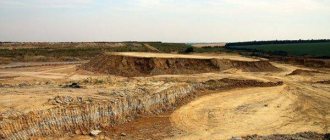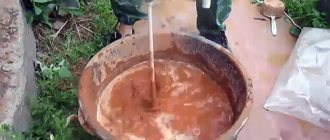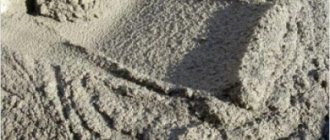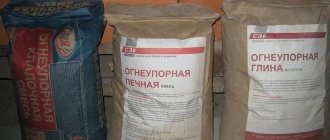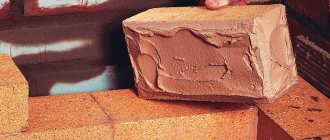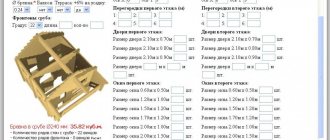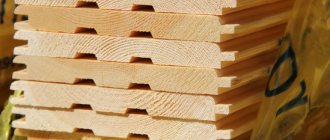The mortar for laying cinder blocks must be of high quality.
After all, the strength of the constructed object depends on it. A weak connection between the elements will lead to the structure quickly collapsing. Read the article about what kind of solution to place the cinder block on and what should be included in this installation mixture, as well as what the requirements are for it and how to prepare it correctly.
What mixtures are used for installation?
The solution is necessary for reliable fastening of building elements to each other. It comes in two types :
- Dry purchased mixture . It is ready to use. The only thing you need to do is add the amount of water indicated in the instructions. The advantage of this composition is that it is easy and convenient to use. Plasticizers have already been added to it, giving it strength. However, it will cost more than homemade compounds. Considering the scale of construction, the amount can be impressive.
- Homemade solution . It is based on several components, the cost of which is low, so the use of such a composition allows you to significantly save your budget. The main disadvantage is the need for strict adherence to proportions. Their violation will negatively affect the properties of the mixture.
Advice! The thickness of the solution layer should be the same for both homemade and ready-made purchased compositions. Its increase does not contribute to increasing the strength of the structure.
Gas block or sand block? Expert comparison of popular building materials. Part 3
Here is the third installment in a series of expert articles about comparing popular building materials. Today we will talk in detail about sand concrete blocks and find out their advantages and disadvantages over aerated concrete blocks.
What is included in sand blocks?
Are sand cement blocks really heavy and more suitable for foundation construction?
Which material is more expensive and what is more profitable to build a house from?
Details in our article!
Part 1. Comparison of brick and aerated concrete
Necessary components for preparation
The classic mortar for laying cinder blocks consists of three components:
Sand .
It must be clean, without foreign impurities that will lead to the formation of lumps. Sand must be purchased at the store. You can make a choice in favor of class II river or quarry sand, or a mixture of both. The grains of sand in it are small, so the adhesion to the surface will be strong.- Cement . The choice should be made in favor of Portland cement, which is a hydraulic binder based on gypsum, cement clinker and additives. Its brand must be no lower than M400 or M500.
- Water . It must be clean, without silt or mold, which can impair the quality of the adhesion of the solution and provoke the destruction of the structure. There should be no excess or deficiency of minerals in the water.
Composition requirements
The mortar for laying cinder blocks must meet the following requirements:
- Spreadability , which allows it to be evenly distributed over the surface.
- Viscosity , due to which it does not flow from the building material.
- Strength after drying, on which the reliability of the erected structure depends.
- Consistency . It should not be too thick and not too runny. By analogy, it can be compared with sour cream.
- Lack of lumps , which is necessary for uniform laying of blocks.
A solution that meets these requirements guarantees the strength of walls and partitions.
Making your own cinder block
Instructions for making the material
In order to make a cinder block yourself, there are certain instructions according to which all actions are performed. This will save money on the purchase of finished building materials, since only raw materials are purchased and then only in rare cases. The solution for making cinder blocks consists of:
- Cement and sand.
- Water and slag.
- Brick chips and wood shavings are added.
This is the most primitive composition of the solution, which anyone can make if desired:
Advice. To increase the strength of the cinder block, various means are added during the mixing of the solution: hardeners. You can also speed up the drying time of the cinder block and additives are also added for this.
- It is not simple cement that is used in the solution, but Portland cement grade 400. As a rule, the ratio of sand and cement is 3 to 1. Depending on the container in which the solution is made, 5 parts of slag are added. Water is half of the cement used.
Advice. The most durable and reliable is cinder block, which is made without the use of sand. In this case, the proportion of slag in the solution increases and 1 bucket of cement accounts for 9 parts of slag.
You will also need special equipment:
- Hollow molds for pouring solid cinder blocks or with special attachments for hollow ones.
- A vibrating table that allows you to evenly distribute the solution in the mold and compact it in it.
- High temperature dryer.
What you need to know:
- At home, the latter device can hardly be found and for this reason all forms are exposed to the sunny side, where they undergo a stage of natural drying.
- This process is quite lengthy, but thanks to this the material does not lose its properties and characteristics.
Advice. To ensure that the solution for making cinder blocks is of high quality and has a uniform structure, a concrete mixer is used to mix it.
Recipe with sand and cement
You can prepare the mortar for laying cinder blocks with your own hands, or use dry store-bought mixtures. Regardless of the chosen solution to the problem, it is necessary to adhere to certain proportions.
How to make it from scratch with your own hands?
To prepare the mixture yourself , follow the following proportions and recommendations :
- Take 1 part cement to 3 parts sand.
- To determine the proportions, use the same container, that is, one bucket or basin.
- When preparing the mixture, you need to take into account the size of the concrete mixer and correlate it with the volume of the measuring container, since it will be impossible to remove or add components to it.
- If you plan to add red clay to the mixture, then take it in the amount of 1/3 of the above proportions.
- Water is introduced gradually, only after the concrete mixer is put into operation. Its quantity depends on the type of masonry. Ultimately, you should get a solution with a consistency reminiscent of sour cream.
Important! Water is poured into one bucket at a time. If you fill the entire volume at once, the solution may turn out to be too liquid. As a result, it will not be possible to use it for masonry, as it will spread.
From ready-made dry materials
Ready-made dry mixtures do not require complex calculations . They already contain all the necessary components; the builder will only have to add water. Such solutions are universal; they can be used for dense masonry and for masonry in a thin layer, but the minimum layer thickness should be 3 mm.
Solutions based on ready-made dry mixtures are used not only for masonry, but also for repairing chips and other damage.
Depending on the brand of the mixture chosen, the amount of water may vary. The manufacturer's instructions will help you determine the exact proportions. Universal recipe for preparing masonry composition :
- The finished dry mixture is poured into a container with clean water at the rate of 0.21 - 0.23 liters per 1 kg of powder.
- Stir for 5 minutes until a plastic mass is obtained.
- Leave the mixture for 2 minutes and mix again.
- Start laying.
Lime must not be added to the finished mixture . This will cause the solution to become less durable after hardening. Red clay and plasticizers are used as components that increase the adhesiveness and density of cement.
Characteristics of cinder block
Cinder block has become very popular recently. This is due to the fact that its price is quite low. In terms of cost, such material is first in the ranking, as it is the cheapest. Types of cinder block:
- Full-bodied.
- Hollow.
- Standard material dimensions: 190x188x390 cm.
- There is hollowness in relation to the entire mass of the cinder block of 30% and 40%.
Advice. Solid cinder blocks are best used for constructing the foundation of a house (basement), as they can withstand fairly heavy loads. Hollow cinder block is used for the construction of non-multi-story buildings.
The most important component for making cinder blocks is slag. Also added:
- Wood sawdust or pine needles.
- Brick chips or scrap.
- Crushed stone or gravel.
- Sand.
- Expanded clay and water.
Thanks to this composition, the cost of cinder block is very low. Not everyone knows that you can prepare with your own hands not only the mortar for laying this material, but also the material itself.
Advice. If both the cinder block and the mortar for laying it are made independently, then there is an opportunity to save a lot on building a house.
The following are built from cinder block:
- Garage and other utility rooms.
- One- and two-story houses.
- Ground floors of the building.
The material is very light and does not require too deep a foundation.
Calculation of consumption per cubic meter
When calculating the required amount of material, you need to build on the type of masonry.
The most common and economically advantageous is masonry of 0.5 - 1 block. In this case, the thickness of the layer will be 1-2 cm. It is no longer recommended to do it, as this will negatively affect the strength of the object being built.
Recommendations for performing calculations:
- Decide on the amount of material needed.
- Calculate the cost of masonry taking into account the thickness of the layer.
- You should not buy material for future use. Store-bought mixtures or consumables for making it yourself are always available for sale.
If you cannot cope with the calculations yourself, you need to contact specialists.
Here is an example of how much mortar needs to be prepared per cube of cinder block masonry: with a wall thickness of 40 to 50 cm and when performing work at a temperature of +5...+25 degrees, the minimum consumption of the mortar is 30-40 kg per 1 m3.
Weight and popular sizes of sand concrete blocks
The weight of blocks with the same volume can be different, which is explained by the presence or absence of voids. So, a 400x200x200 block can weigh 22, 24 or 30 kg. In general, the approximate ranges are as follows: wall blocks weigh from 8 to 40 kg, foundation blocks - from 100 to 2000 kg.
Dimensions of wall blocks, mm:
- length - from 190 to 500
- width - from 90 to 500
- height - from 185 to 300
Dimensions of foundation blocks, mm:
- length - 880, 1180, 2380
- width - 300, 400, 500, 600
- height - 280, 580
What other mixtures can be used?
To prepare the solution, you can use different types of mixtures, including :
- Composition for masonry M25. It is based on M300 cement with the addition of one part of sand.
- The M75 solution is based on the M400 solution with the addition of lime (0.5 parts) and sand (4 parts).
- Mixture M100. It is based on M400 cement, 0/3 parts lime and 4 parts sand.
- Mortar M150 based on cement with 2.5 parts sand and 0.1 parts lime.
Adhesive for cinder blocks
Adhesive for cinder blocks is often used instead of classic masonry mortars. It has a number of advantages :
- Increases the strength and durability of an object.
- Economically consumed per 1m3.
- Allows you to achieve good adhesion of blocks, which is possible due to the presence of fractional sand in the composition.
Glue is more expensive than conventional solutions, so it is advisable to use it in cases where the surface of the blocks is not porous and has ideal smoothness.
Another option is to carry out work in winter. The use of glue allows for better hardening of the seams.
Popular brands of adhesive for cinder block:
- Bergauf Kleben Block. Frost-resistant adhesive for cellular blocks.
- Normada.
- Ceresit ST 21. Adhesive for laying cellular concrete blocks.
Transportation
Since sand concrete blocks of the same size can have different weights, the number of loaded units also varies. So, in a car with a carrying capacity of 20 tons, from 700 to 900 blocks with a volume of 400 × 200 × 200 mm are placed.
The shipment and transportation of the product should begin only after the concrete strength has reached the required value (tempering strength).
At the warehouse site or directly on the production line, the blocks are placed in flat or rack pallets, wrapped in film (shrink or stretch) and tied with steel or polymer tape. The height of the transport package formed in this way should not exceed 1.3 m.
When storing, ready-made transport packages are placed on the loading platform in stacks (in one or two tiers), maintaining a distance between them of at least 0.5 m. Blocks that have blind voids are placed in the package with the voids facing down.
Average prices
The price of compositions for laying cinder blocks depends on the manufacturer and the markup set by the retail outlet.
Average cost of products in the Russian Federation :
- Glue – 350 rubles for 25 kg.
- Ready-made mixtures – 200 rubles per 25 kg.
- Cement M500 (for preparing the solution yourself) – 300 rubles per 50 kg.
So, glue is more expensive than other compounds . The price for ready-made dry mixtures is slightly lower, and the most budget-friendly option is to prepare the solution yourself.
